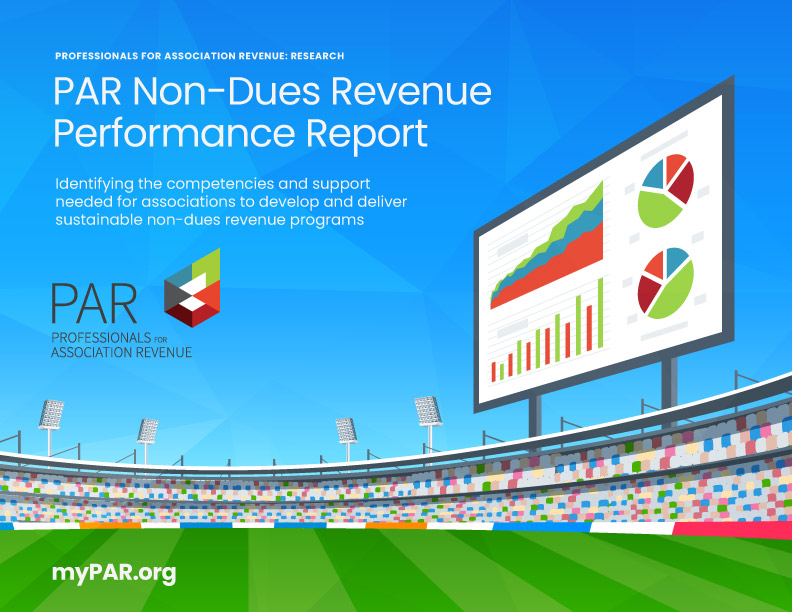From Peaks to Valleys: Mastering Non-Dues Revenue with Strategic Leadership

By Carolyn Shomali, PAR
Developing a thriving non-dues revenue program isn't just about the right ideas; it hinges on effective leadership and streamlined internal processes. In the Professionals for Association Revenue (PAR) Non-Dues Revenue Performance Report, association executives in leadership positions accounted for 48% of the respondents - an encouraging piece of data that indicates a rising leadership commitment to non-dues revenue.
Voices in this Article
 Sean Soth
Sean Soth
PAR | Leadership Advisory Board Chair
 Teri Carden
Teri Carden
Non-Dues-a-Palooza | Founder
 John Bacon, MBA
John Bacon, MBA
ASAE | VP, Enterprise Sales
 Jim Elliott
Jim Elliott
James G. Elliott Co | President
But to propel this commitment into action, it's crucial for association leaders to develop a non-dues strategy that is directly tied to providing value for association stakeholders. And, to understand that challenges and discomfort will inevitably arise as the strategy is implemented.
“When we're committed to a strategy, that also means that we're going to take some steps that may be challenging and painful,” says Sean Soth, PAR’s Leadership Advisory Board Chair. “You will have peaks and valleys, but I think as association leaders, we need to understand how to get our teams and our organizations out of those valleys more quickly.”
Data based decision-making and internal collaboration are the foundation of any non-dues revenue strategy. Here are five ways to use both in your association’s strategy development.
1. Utilize Member Surveys
Member surveys are instrumental in understanding not just what members want but what they are willing to pay for, providing crucial insights for tailored, member-centric strategies. John Bacon, Vice President of Enterprise Sales for ASAE, says COVID-19 forced associations to shift from assuming what members want to actively listening to them.
“There was no more assuming or no more saying, ‘We've always done it this way.’ [Leaders] wanted to really understand their members and stakeholders to really find out what they wanted and needed and how can we get that in front of them,” Bacon says.
2. Conduct a Gap Analysis
Once member preferences are known, a candid assessment of current offerings is paramount. Gap analysis, as Bacon suggests, distinguishes between real and perceived gaps, ensuring strategies align precisely with genuine member needs. The focus shifts to tangible benefits, and leaders must ensure that offered programs and services provide real value, compelling members to invest.
"As leaders, we have to focus really on the values of the programs and services that we offer. And make sure that they're real tangible benefits for the members and making sure that they're willing to pay for it," Bacon emphasizes.
Bacon’s emphasis on member value underscores the PAR finding in which 80% of respondents said “value to member or business partner” was the most impactful contributing factor to non-dues programs performing over budget.
3. Use Data to Drive Decision Making
In the age of information, data-driven decision-making becomes non-negotiable. Leaders must weave data into the fabric of their strategy, ensuring that every move is backed by a deep understanding of member behaviors, preferences, and needs. This approach not only fuels sustainable revenue growth but also cultivates a culture of adaptability.
“We’re seeing a lot more data driven decision making which, really in turn it allows us to really make sure that we're evolving the right way because we're listening to our members,” Bacon says.
4. Survey Your Resources and Grow from Within
Developing a non-dues revenue strategy means understanding the association’s resources and overall capacity. Enthusiasm for growth initiatives often collides with the reality of limited resources, causing implementation challenges. This reality is illustrated in the PAR finding in which 31% of respondents said “internal interest” was the largest hurdle to building non-dues revenue. When associations lack resources and operate in silos, internal interest fails.
Jim Elliott is the President of James G. Elliott Co., an outsourced advertising sales company, and says associations must foster a culture of collaboration in the way successful corporations do.
“People are protecting what they're doing instead of working collaboratively. If you were in the commercial world and you played the silo game, [you would fail],” Elliott says.
Part of combating a lack of internal interest is honestly assessing internal resources. If the association lacks the sales capacity to sell and implement non-dues programs, an outside sales team may be the answer. Whether the sales team is internal, outsourced or hybrid, Elliott says it’s imperative that someone owns the sales process.
“If there isn't someone that owns it, it will die of loneliness,” Elliott says. I can't tell you how many times we’ve seen projects where nobody owns it and it just disappears.”
5. Assess the Competition
Non-dues revenue programs do not operate in a vacuum, but instead among the noise of competition. Surveying the market and understanding if you have the appropriate resources to elevate your product above the competition is a critical step in strategy development.
“There’s a lot of commercial players here and if you don’t have an enormous marketing budget to expose the product or service that you are trying to unveil, then it becomes the very time consuming one sales call at a time,” Elliott notes.
The good news, according to Non-Dues-a-Palooza founder Teri Carden is that associations have one thing that sets them apart from competitors: their members.
“A lot of times our industry partners or people that are in our in our industry want to know a little bit more from our members and our constituents. And instead of developing a focus group or hiring a research company, they could go to the association, and they can say, ‘Would you be willing to ask a survey question on behalf of our company?’ I know some organizations that are bringing in up to $25,000 for a single piece of research like that,” Carden says.
Developing a robust non-dues revenue strategy demands more than visionary ideas—it requires leadership and intentional strategy development. By navigating member preferences, leveraging data, collaborating internally, and assessing competition, associations can begin to strategize around a sustainable non-dues program.
PAR Non-Dues Revenue Performance Report
Nearly 100 association executives and industry consultants responded to the Non-Dues Revenue Performance Survey to share their insights in:
- The leadership strategies needed to support non-dues revenue performance
- The process and activities that support a successful non-dues revenue effort
- The contributing factors to non-dues revenue performance and success.
